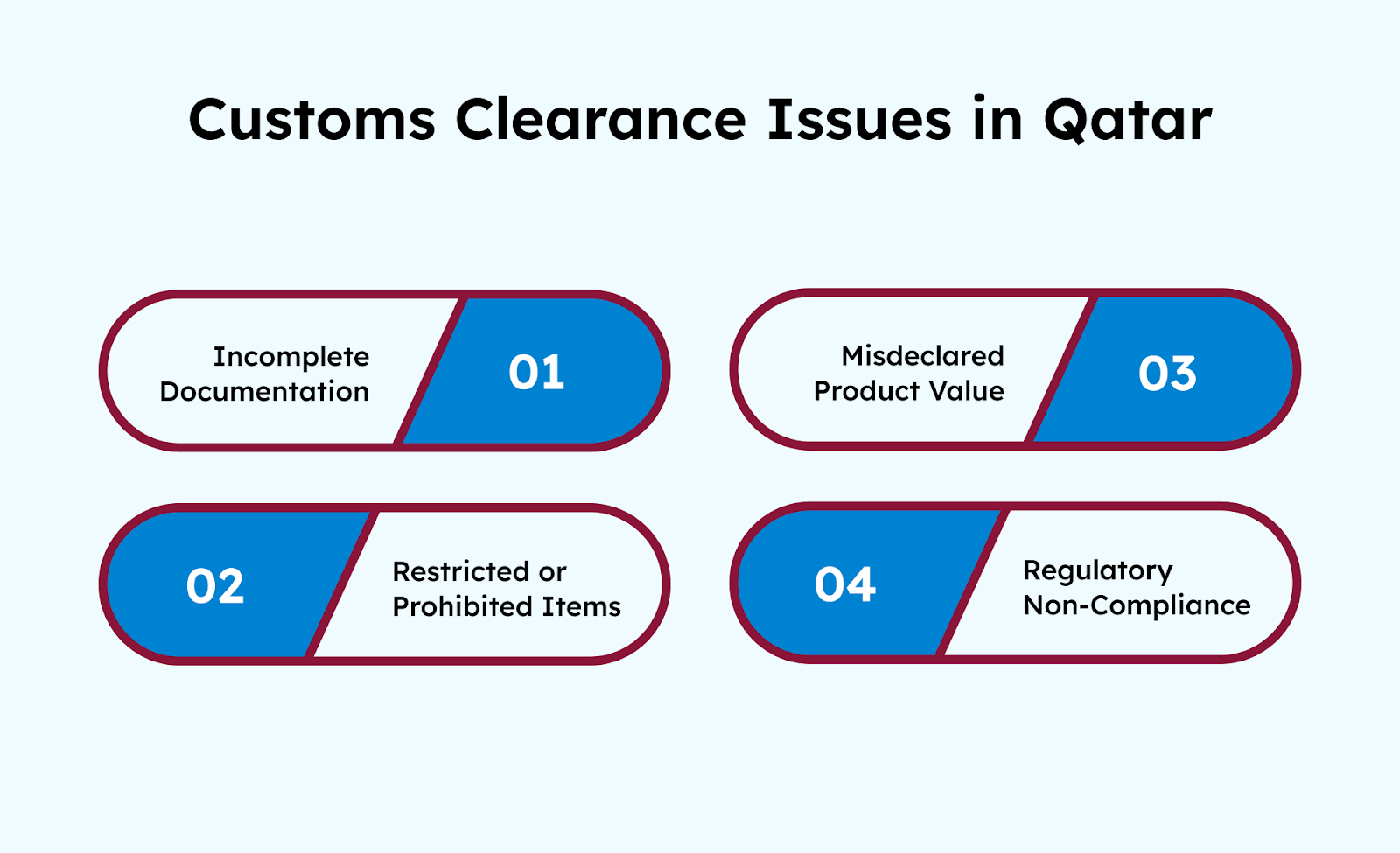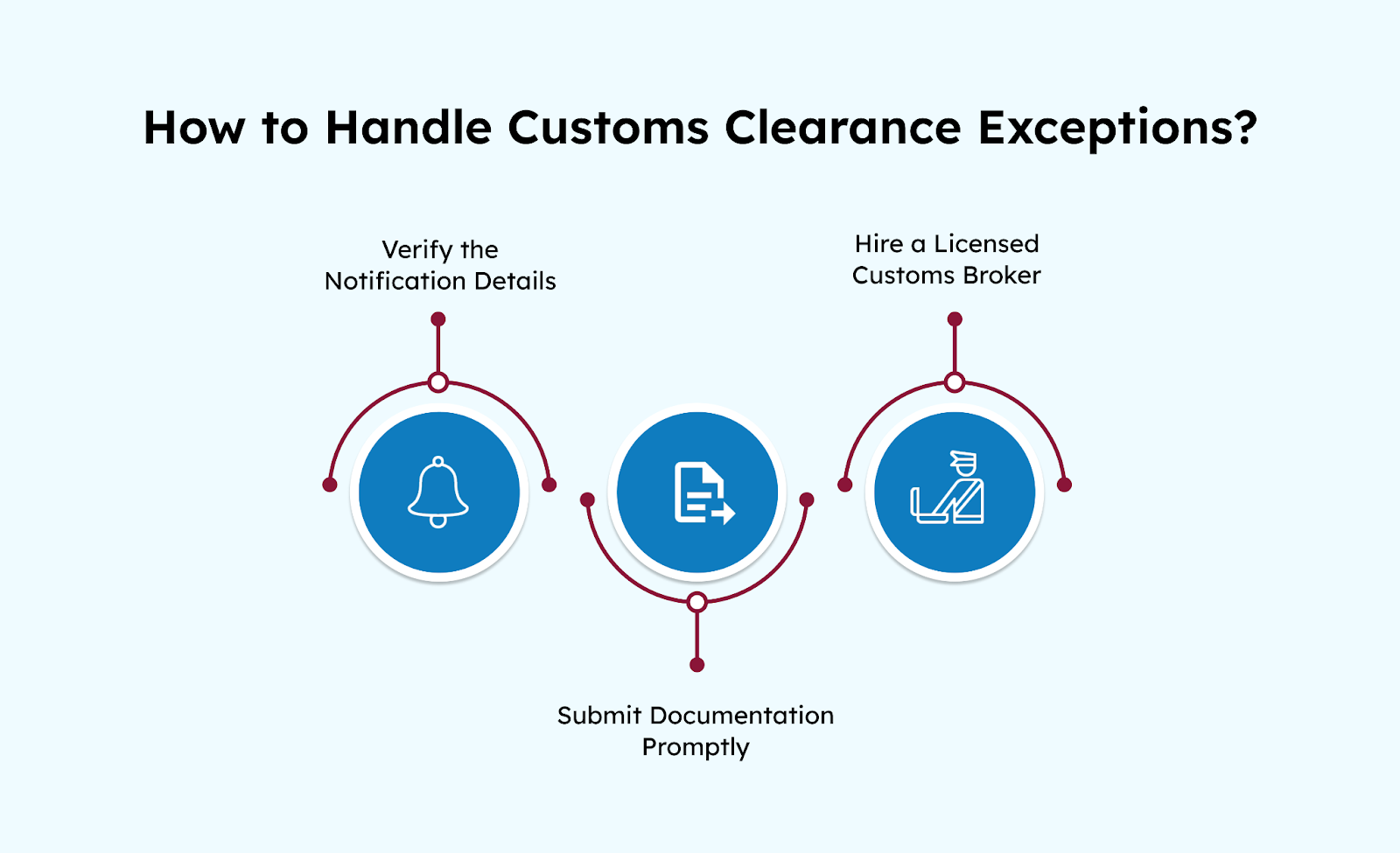Customs Clearance Exception: Meaning and How to Handle It
.jpg)
Shipping goods in and out of Gulf Cooperation Council (GCC) countries, especially Qatar, is a smooth process until something unexpected happens. A customs clearance exception can suddenly stall your shipment and lead to frustration, especially when the cause isn’t immediately apparent.
The General Authority of Customs (GAC) typically releases around 85% of unrestricted goods in less than one hour, while clearance for government bodies averages three hours. However, issues like incomplete paperwork, growing regulations, or items flagged for further checks can extend the timeframe and disrupt deliveries.
This article breaks down what a custom clearance exception really means, why it happens, and how you can stay one step ahead to avoid delays that affect your bottom line.
What Is a Customs Clearance Exception?
A customs clearance exception is any disruption in the standard processing of a shipment at a country’s border. Instead of passing smoothly through inspection, the cargo is flagged due to a compliance concern, missing documentation, or regulatory mismatch. These exceptions can lead to minor delays or escalate into significant hold-ups, blocking goods from entering or exiting entirely.
Also Read: The Complete Guide to Customs Clearance in Qatar
How Will You Be Notified About Flagged Shipments?
Fortunately, the logistics infrastructure in Qatar, particularly at Hamad Port and Hamad International Airport, is digitally integrated and responsive. If your shipment is flagged, you’ll likely receive a notification:
- An email or SMS from customs or the carrier.
- Real-time tracking platforms like Al Nadeeb system, Aramex, DHL Express, or Qatar Post.
These updates usually include the reason for the exception and step-by-step guidance, such as resubmitting documents, clarifying shipment value, or paying additional duties.
Need help clearing customs? Contact WareOne today and manage your next shipment with our expert custom clearance services.
By understanding how and why these exceptions occur, businesses can optimise future shipments and reduce the risk of unexpected delays.
Common Reasons Behind Customs Clearance Exceptions

Identifying the typical triggers for customs clearance exceptions is key to avoiding disruptions and ensuring smoother trade operations. Several recurring factors often lead to such setbacks:
1. Incomplete or Incorrect Documentation
Documentation errors are one of the most common causes of shipment delays. Even a minor oversight, such as an incomplete commercial invoice, a missing Certificate of Origin, or an expired import license, can cause clearance to be halted. Since most shipments are reviewed electronically first, these issues are often identified and flagged before physical inspection.
2. Restricted or Prohibited Items
The GCC countries enforce strict regulations on import categories, and violating these can result in immediate holds or rejections.
- Prohibited goods include certain types of alcohol or pork products (without permits).
- Restricted items such as drones, advanced electronics, or chemicals require prior approval.
Shipping such items without the appropriate documentation or licenses will almost always result in an exception.
3. Misdeclared Product Value
Declaring inaccurate values, whether intentionally to reduce duty costs or due to clerical errors, raises red flags. Customs officials cross-verify declared values with market data and previous imports. If your declaration appears inconsistent, your shipment may be subject to a full inspection, which can slow down the process.
4. Non-Compliance With GCC-Specific Regulations
Some products require category-specific compliance before entry into GCC countries.
- Food and beverages need health and halal certifications.
- Medical devices require clearance from the Ministry of Public Health (MoPH).
- Electronics need energy efficiency or safety labelling.
Failing to meet these localised standards can result in customs exceptions that may take days or even weeks to resolve.
But what happens when these exceptions aren’t handled swiftly? Let’s examine the broader business implications of customs clearance exceptions.
Also Read: What is Customs Clearance: Process and Tips
What is the Business Impact of Customs Clearance Exceptions?
For businesses, particularly in the burgeoning e-commerce sector, customs clearance exceptions can have a ripple effect:
- Delivery Delays that Undermine Customer Trust: In today’s instant gratification world, delayed deliveries lead to frustrated customers and potentially harmful reviews. In this competitive online retail space, speed and reliability are major differentiators.
- Disruptions in Supply Chain Flow: A hold-up in customs can disrupt your entire supply chain, impacting inventory, production schedules, and even order fulfilment. For businesses managing just-in-time inventory systems in a fulfilment centre, even minor interruptions can escalate into operational setbacks.
- Financial and Reputational Risks: Unexpected storage fees, fines, or re-export costs can quickly erode your profit margins. Moreover, repeated customs exceptions may label your business as high-risk in shipping databases, increasing scrutiny on future imports.
Tired of customs delays? WareOne offers expert customs clearance for fast, compliant, and hassle-free shipments.
Recognising the impact is only half the equation. Resolving exceptions quickly is where businesses can truly stay ahead. Here’s how to handle them effectively.
How to Handle Customs Clearance Exceptions?

When a shipment encounters a customs roadblock, swift and informed action is crucial to avoid extended delays or additional costs. Here’s how businesses can effectively respond:
- Verify the Notification Details: Review the exception notice carefully. Carriers like DHL, Aramex, and FedEx typically specify what is missing or incorrect, whether it be documentation, item classification, or fees due.
- Correct and Resubmit Documentation Promptly: Whether it’s an expired permit, missing HS code, or undervalued invoice, make sure that all necessary corrections are submitted immediately to customs authorities or through your shipping provider’s portal.
- Engage a Licensed Customs Broker: In high-value sectors like healthcare or tech, customs issues can get complex. A licensed broker can clarify regulations and fast-track resolutions with local authorities.
While resolving customs clearance exceptions is essential, preventing them is even better. Proactive planning not only saves valuable time and resources but also helps maintain momentum in the supply chain.
Proactive solutions from WareOne can help prevent customs clearance exceptions. Start by optimising your shipping and documentation process.
What are the Prevention Strategies for Future Shipments?
While not every exception is avoidable, careful planning and thorough documentation can prevent many issues before they arise:
- Proper training on international shipping requirements: Provide your team with targeted training on GCC’s trade regulations, including the appropriate documentation practices and up-to-date lists of restricted and prohibited goods.
- Use of advanced tracking and notification systems: Use advanced carrier tracking tools that provide real-time updates and proactively flag potential issues by analysing tracking data to detect exception patterns and support preventative action.
- Regular audits of shipping procedures: Periodically review your shipping processes to identify and rectify any recurring errors or omissions in documentation or compliance.
- Plan around extreme weather: Sudden sandstorms or seasonal rain can ground flights or delay ground transport. Constantly monitor weather forecasts and choose flexible shipping windows when possible.
- Double-check shipping labels: Ensure that all labels are securely attached and printed in both English and Arabic. Smudged or missing details can lead to customs processing issues at ports.
- Account for public holidays: National holidays, such as Eid or National Day, may cause a pause in customs and logistics operations. You should schedule shipments to avoid these periods or build buffer time to ensure timely delivery.
- Coordinate delivery with the recipient: If the recipient is unavailable, especially for business deliveries that require signatures, your package may be held or delayed. Always confirm delivery times in advance.
How WareOne Simplifies Customs Clearance?
Avoiding customs clearance exceptions starts with the right systems, and WareOne provides just that. With a tech-driven, full-service approach, it helps businesses streamline cross-border logistics and stay compliant at every step.
Here’s how WareOne supports you:
- End-to-End Customs Documentation: From commercial invoices to certificates of origin, WareOne ensures that every document is complete, compliant, and ready before your goods ship.
- Speedy Approvals: With our close coordination with customs authorities and pre-clearance strategies, shipments move faster with fewer hold-ups.
- Real-Time Shipment Visibility: Track your cargo through WareOne’s centralised dashboard and receive instant notifications if any clearance issues arise.
- Multi-Port Coverage: Whether you’re shipping via Hamad Port or Hamad International Airport, WareOne handles procedures effortlessly across key transit points.
- Compliance-First Operations: WareOne stays ahead of growing import/export regulations, minimising the chances of documentation errors or regulatory violations.
- Customs Expertise on Call: Our in-house specialists are available to guide you through complex classifications, valuation standards, and permits specific to your cargo.
- Seamless Hand-off to Final Delivery: Our streamlined customs process directly enables a smooth transition to warehousing and distribution services, ensuring your goods move effortlessly from port to their final destination.
By integrating these services, WareOne helps reduce the risk of customs clearance exceptions, giving your supply chain the reliability and speed it needs.
Conclusion
Customs clearance exceptions can disrupt shipments and cause unnecessary stress. But with the proper preparation and reliable support, these issues don’t have to derail your business. From understanding the causes to improving your documentation and processes, staying informed is key.
WareOne offers curated customs clearance solutions designed to help businesses avoid common errors and meet GCC’s import requirements without added hassle. Their integrated services and clear communication can make a real difference when time and compliance matter.
Need help clearing customs in Qatar? Contact WareOne today and manage your next shipment with expert support.
FAQs
Q1. What does a custom clearance exception mean?
A. A customs clearance exception means your shipment has encountered a delay during the customs process, often due to missing documents, unpaid duties, or inspection.
Q2. Why did my package get a customs clearance exception?
A. Common reasons include incomplete paperwork, incorrect HS codes, unpaid duties, or goods flagged for further inspection by customs authorities.
Q3. How long does a custom clearance exception delay a package?
A. Delays vary but typically last from a few hours to several days, depending on the complexity of the issue and the speed of its resolution.
Q4. Can I fix a custom clearance exception myself?
A. Yes, in many cases. Contact your carrier or customs broker to provide any missing documents, pay any outstanding duties, or clarify product details to resolve the issue.
Q5. What happens if a customs clearance exception isn’t resolved?
A. If not resolved, your package may be returned to the sender, held indefinitely, or even seized by customs, depending on the severity of the issue.
Q6. Who should I contact for a custom clearance exception?
A. Reach out to your shipping carrier, customs broker, or local customs office to understand the reason and steps needed to clear the exception.